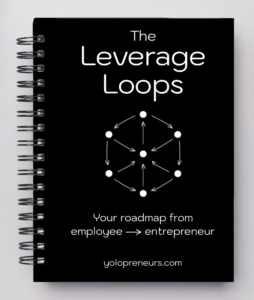“Go to school, get a good job, retire at 65”
That’s advice lots of us hear and follow.
The reality is that this formula will not lead to a life of fulfillment.
Instead, you wake up at age 50, burnt out, and wondering where the time has gone.
Education is important, but traditional schools condition kids to be employees.
In the digital age, there’s a better way to succeed.
It’s establishing a one-person business. Those who do so are called solopreneurs.
You can still learn how to do this. More importantly, your kids can learn how to do this.
This path is not taught in traditional schools, so I outline it in this newsletter.
"Some people die at 25 and aren't buried until 75"
- Ben Franklin
The grind
In high school, I knew I didn’t want to be average. I wanted to be rich.
I thought the path to riches was a high-paying job.
Earn a high salary, invest the money, and watch it grow.
Then, retire early and live off the passive income. Simple.
At the time, the highest paying jobs were in engineering.
- I worked hard in high school to get into a top engineering college.
- I worked hard in college to get into a top engineering graduate school.
- I worked hard in graduate school to get a top engineering job.
With a Master’s degree in engineering, my first salary was $80k / year.
7 years of grinding in college and graduate school, but it was worth it. At least, that’s what I thought.
As the years went by, that $80k salary grew with promotions and a few job changes.
But, so did my expenses. House, cars, family needs.
I was making more money, but I was not saving more.
Certainly not enough to “retire early” and live off my investments.
Escaping the matrix
I finally internalized the fact that you can’t save your way to financial independence.
Unless something changed, I would be working a 9-5 job until I was 65.
At 40 years old, I started my own engineering consulting company.
I’ll talk more about how I did that in a future newsletter.
But, this got me thinking: why did I stick so long with being an employee?
I realized that devoting 8+ hours a day working on other people’s priorities left little creative energy to work on my own.
Wake up, go to work, come home, watch TV, repeat. Day after day.
Being an employee is a difficult trap to free yourself from.
Even worse, this trap is first set in traditional schools. Think about it.
Traditional school students are like employees:
- sit in a building
- adhere to rigid schedule
- do work that’s given to you
- finish work at home in the evenings
Homeschoolers, on the other hand, are like solopreneurs:
- learn from anywhere
- follow a flexible schedule
- do work that interests you
- enjoy family time in the evenings
My wife and I are homeschooling our three kids from K-12.
Homeschoolers have the time to discover what they’re passionate about, what people need, and how they can offer something valuable.
Having time to focus on their priorities is critical to avoiding the default path in life.
The Yolopreneur Homeschool Curriculum
I list the basic approach to starting a one-person business in high school below.
Once started, each step continues on through to the end.
I will expand on each of these in future newsletters, but all can be done in 2 hours per day.
Spend more time each day and it can be accomplish in fewer years.
9th grade – Research your interests: Students start solving problems for themselves so that they can then teach others. For high school students, this could be how to improve a baseball swing, how to study for an AP test, how to play the guitar, etc. They also learn foundational skills such as copywriting and image editing.
10th grade – Cultivate an audience: Students build a community around their interests by writing about them with an anonymous account on X (formerly Twitter). They learn more and refine the approach through engagement with others having the same interests. This audience will serve as a distribution network in the future.
11th grade – Launch a newsletter: Students develop a website and write a weekly newsletter. This is the platform from which they will share deeper insights and build authority. They are now teaching those two steps behind them how to solve the same problem(s). These newsletters will also be used to build an email list and serve as the basis for other types of media (podcasts, videos, etc.)
12th grade – Sell products: Students create a digital education product that can be purchased and downloaded from their website. These are typically text-based courses accompanied by short video explanations. A market for these products exists because the student has built an audience and has established the necessary authority with it.
The hard part is now done. The students have a platform and distribution channel to evolve as their interests change after high school.
Earnings will increase as they continue to expand their audience and offer additional products.
If they want to go to college, they can run this operation on the side.
To Wrap Things Up
Deep down, you recognize that the “go to school, get a job, retire at 65” path you are on will not lead to fulfillment.
Your kids aren’t aware of alternatives to this path any more than you were at their age.
As parents, the greatest gift we can offer is the benefit of our hindsight.
I encourage you to consider homeschooling your kids.
But, at a minimum, introduce them to the idea of solopreneuring.
Warm regards,
The Edupreneur



